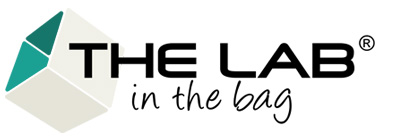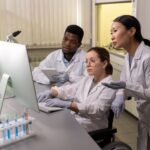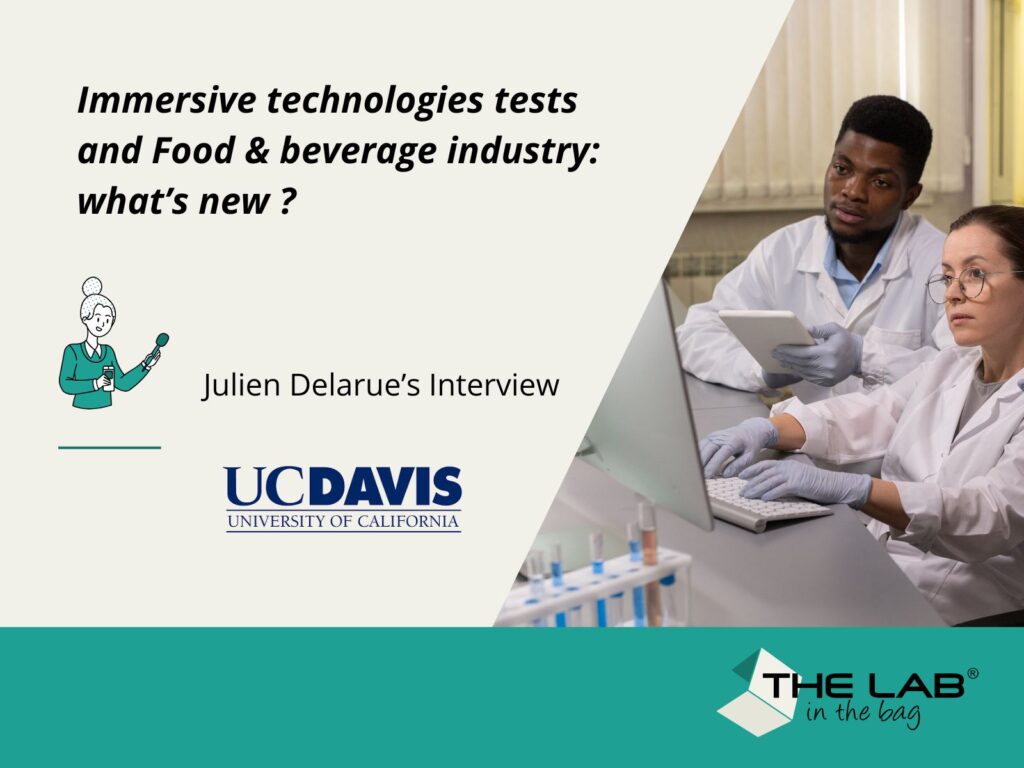

Interview with Julien Delarue’s at UCDAVIS
Immersive technologies tests and Food & beverage industry: what’s new ?
A l’heure de l’évolution exponentielle des technologies d’immersion sensorielle, nous avions à coeur de poser quelques questions à Julien Delarue, Sensory and Consumer science specialist at the UC Davis, sur la genèse et l’évolution un secteur en pleine expansion : l’Extended Reality (XR),
Hi Julien, can you introduce yourself?
I’m Julien Delarue, a French PhD with twenty years of experience working in sensory research.
I’m a sensory and consumer science specialist in the UC Davis… My field has mostly been applied in the food industry, but nowadays it is becoming available in the mass market : cosmetics, sports equipment, automotive industry, etc.
And researcher… I have worked a lot on the role of context on consumer perceptions and preferences.
What is the sensory test methodology?
In sensory analysis, we usually work in laboratories to be able to control the conditions of evaluation using sensory cabins.
But this test methodology raises questions because people do not consume food products in sterile conditions. Hence the importance of thinking about the context to stimulate more.
Before immersive techniques arrived, we were wondering: should we carry out tests in the laboratory where everything is controlled, or is it better to carry out the tests at home, in restaurants, in real life?
We quickly realized that we could miss information with the test in the laboratory. This is explained by the subjective experience and the feelings of the testers. If we work in a test environment that is too superficial, we make the experience too analytical and we deprive ourselves of the subjective experience. To circumvent the problem raised, now we can use immersive tests.
What are the different options of immersive testing ?
- Either you can use immersive testing in a natural context or recreated by living labs, which are studios made by designers to recreate environments in which consumers move and which provide an understanding of their immersive testing experience.
Ex: the experimental restaurant of the Paul Bocuse Institute. - Or in a lab with some context elements recreated, brought in. That explains the gradual rise of immersive techniques in the consumer research sector. Included virtual reality or the flower pot in the sensory cabin to make the experience less artificial
What changes have you noticed in sensory analysis in the last twenty years?
We observed a significant development of sensory analysis over the past 10 years thanks to the work of Dr Christopher Simons, researcher at the University of Ohio.
Simons was the first to image consumer tests by setting up video walls, screens…
For example : recreate a coffee shop atmosphere for Starbucks
He showed that results were quite different and much more sensitive in terms of preference with this type of test rather than with those in laboratories. These studies have generated a lot of enthusiasm. Professionals like me said to themselves, ‘hey, there is something to do!’.
Initially, some university researchers were refractory, ‘we must continue to work as a good scientist, in an empirical and rigorous way’. It’s a little past today, especially with the arrival of social sciences in the sensory sector: psychology, anthropology, etc.
There is always a latency period between the moment a new method comes out and the moment it will be used: here 10 years. The industry very quickly took an interest in these tests, particularly the cosmetics sector.
There has not been a major technological evolution in terms of immersion techniques but a change in approach.
The automotive industry worked 20 years ago on virtual reality spaces, caves, which are now completely obsolete but which recreate 3D reality. We felt like we were in a car thanks to 3D projection systems.
By focusing on the immersive point of view in sensory, we were more interested in the aspects of consumer perception, a little less in the technical aspects. I think that is the way the shift really happened.
The other element is the price drop of equipment.
Projectors have become very cheap, VR headsets are affordable (around 500€), compared to 10 million… It has become very accessible, technological evolution has allowed the democratization of immersive tests.
Today, all you need is a space with video projectors, good video quality and good speakers. The flexibility and transportability of the equipment really makes the difference.
Companies play a lot on immersion in universes. This is done a lot, particularly in the area of geography, culture and wine. There was recently an exhibition of Van Gogh in 3D in San Francisco, which was in Paris in 2020.
There are two aspects of immersive use: showcase or research. Maybe other uses later, but the evolution has been slowed down for 2 years with the Covid.
Which needs for the UC Davis ?
I was the first user of the first version of The Lab In The Bag’s Immersive Room. I haven’t tested the new version yet and I can’t wait! I want to continue using the room to study the effects of context on people’s perceptions.
Using The Lab In The Bag’s Immersive Room will allow me to have much more accurate research results, placing people in predetermined situations, and seeing if that changes their expectations, their perceptions and their preferences.
For example, I consume a snack differently depending on whether I am at home on my sofa, in front of my desk, at the gym, riding my bike, at the beach… Everything will change, not only the perception but also my way of eating the product, the practicality of the packaging, etc. This is the subject of my research in the UC Davis.
Sources :
https://www.forbes.com/sites/johnkoetsier/2020/06/12/covid-19-accelerated-e-commerce-growth-4-to-6-years/?sh=28da60d1600f https://www.journaldunet.com/ebusiness/commerce/1496695-de-l-importance-des-experiences-immersives-en-periode-de-distanciation-sociale/ https://www.immerseuk.org/resources/ https://www.immerseuk.org/wp-content/uploads/2019/11/The-Immersive-Economy-in-the-UK-Report-2019.pdf


